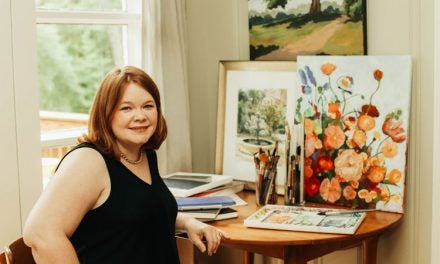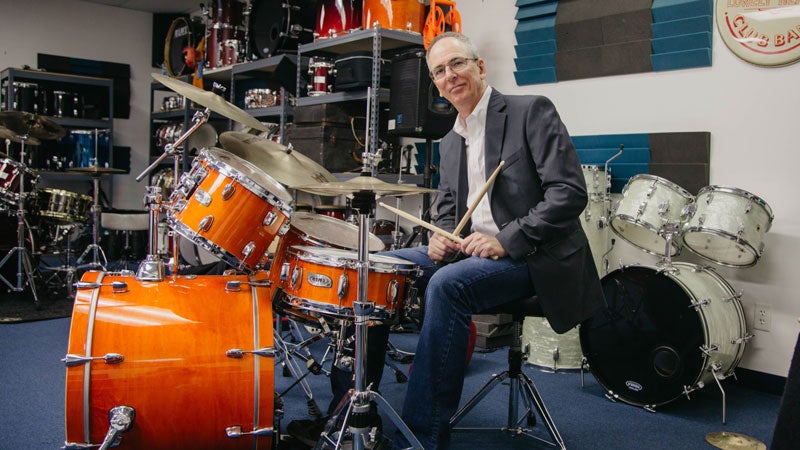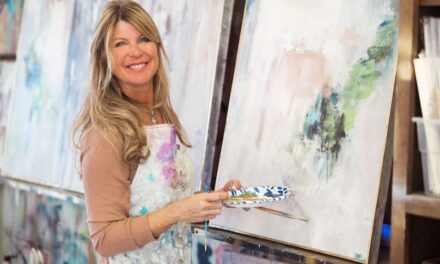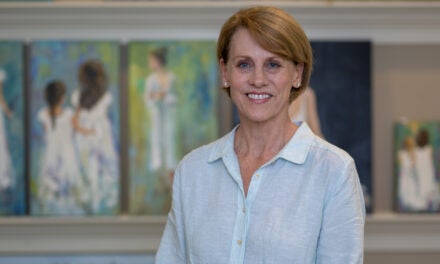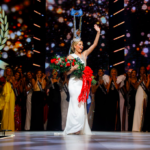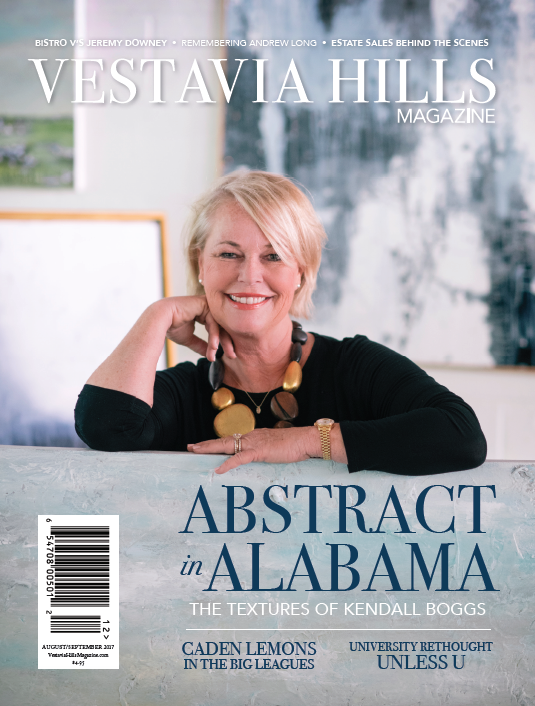By Ashley Tiedt
Photos by Blair Ramsey
When one first looks at one of Joan Curtis’s vibrant, textured paintings, it’s hard not to be drawn into her world. As an abstract and figurative painter from Vestavia Hills, Joan creates her unique pieces using a palette knife instead of a traditional brush.
“I’m a palette knife painter, so that’s why my figures are not very realistic,” Joan says. “Because I’m using a palette knife, not a brush, I like how it gives you abstractness you cannot create [otherwise]. You’re trying to be realistic with a brush, and I’m not trying to be realistic. I’m just trying to get a feeling up there.”
Joan’s artistic perspective so cleverly paints into reality that which surrounds her—her distinct authorship of life. Her gallery of artwork ranges from abstracts to figures, florals, landscapes and cityscapes.
Despite the varied subjects, Joan’s signature palette knife technique ensures a unique quality in all her pieces.

The Art of the Palette Knife
Palette knife painting is a unique and dynamic approach to creating art. This method involves applying thick, textured paint strokes, resulting in a highly expressive and tactile surface that adds dimension to the artwork.
This results in various effects, from sharp, defined edges to soft, blended areas. Painting with a palette knife can be faster than brushes, as the knife can quickly cover large areas.
“I enjoy travel, flowers, pretty things and color,” Joan says.
These picturesque views prove advantageous for Joan, who is able to capture the immediacy and energy of a scene through her stylistic techniques. By applying thick layers of paint with her palette knife, the paint itself is less prone to cracking over time.
This durability makes palette knife paintings well-suited for long-term display. Acrylic paint is Joan’s medium of choice—a decision rooted in her time at the University of Alabama in the 1970s.
“I started painting in the ‘70s, and that’s when acrylic paint became an increasingly popular medium used in art,” Joan says. “I never painted with oil, never once.”
Her decision to stick with acrylics has become a defining characteristic of her work.

Joan’s Artistic Journey
Joan’s journey as an artist began early.
“I’ve been an artist since I was a little girl,” she says. “I didn’t paint then, but I’ve always drawn and loved crayons. I love Crayola crayons.”
She pursued her passion further in high school, and later at the University of Alabama, where she received a degree in art education and also a degree in nursing. After tying the knot with her husband, Alan, Joan moved to Birmingham and began working in the Division of Pediatrics in Cardiology at UAB Hospital.
“I became a nurse and put my art back on the back burner, but I always painted a little bit,” Joan says. Joan maintained her artistic spirit, even as she juggled raising her children and her job as a nurse. “I only worked two days a week as a nurse. So, I had the other three days to paint as long as my kids were in school.”
Joan retired from nursing in 2019 and was able to commit more time to her craft. Her youngest child was in high school at the time, so Joan found the time to participate in outdoor art festivals.

These played a crucial role in her development as an artist.
“I started doing outdoor shows, like big festivals in Birmingham, Louisville, Kentucky and Atlanta,” she says.
These events provided exposure and helped Joan hone her style and connect with a broader audience. She and Alan often travel to art shows, set up professional tents and manage the logistical challenges of her now being a full-time artist. Their partnership, both in life and art, spans more than 51 years, beginning when they met at 15.
“Truthfully, I couldn’t do it without him,” Joan says.
Joan’s art reached new heights during the COVID-19 pandemic as people began redecorating their homes.
“People were coming to me, and I wasn’t out there beating the bushes,” Joan says, reflecting on the increased demand for her work.
This period saw her creating more and reaching a wider audience across the United States, from California to upstate New York. Joan also became sought after for her one-of-a-kind, commissioned pieces, which form a significant part of her work.

Joan often collaborates with clients to bring their visions to life in her distinctive style.
“A client wanted an elephant, and I said, ‘Well, it’ll be in my style. Will you like it?’ She said, ‘Absolutely,’ and it turned out well,” Joan says.
In addition to outdoor festivals and commissioned work, Joan’s art is showcased in several galleries and high-end showrooms, including the John Richard Collection in Atlanta, which features paintings in Neiman Marcus and other prestigious locations.
“I’m proud to be one of his artists,” she says.
Looking ahead, Joan does not plan to slow down. The beauty in art, she believes, is that it is something she can do at any age, almost anywhere.
The best part, however, is that she gets to create from the heart for the people she holds dear to her heart—and that is more than enough to make her career worthwhile.
To commission a painting or purchase one of Joan’s pieces, visit joancurtisart.com or follow her on Instagram @joancurtisart.

Signature Style – Palette Knife Painting
Palette knife painting is unique in that it does not use a paintbrush, but it instead utilizes a palette knife, which is typically used for mixing colors on a palette. Artists use the flat, flexible blade to apply and manipulate paint directly on the canvas. The knife can be used to spread, scrape and layer paint, creating various textures and effects that are difficult to achieve with brushes.


